16
Formative Assessment: Magnets
What is Magnetism?
A magnet is an object or material that produces its own magnetic field. Magnets are dipoles meaning they have two poles: a north and a south. Opposite poles (north and south) attract while similar poles (north and north, south and south) repel each other. Magnetism is the force that attracts or repels objects within the magnetic field.
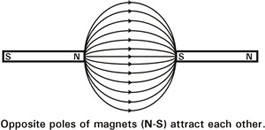

A magnetic field is the area around a magnet that has magnetic force. The image, below, shows the two poles of a bar magnet and the magnetic field it generates.
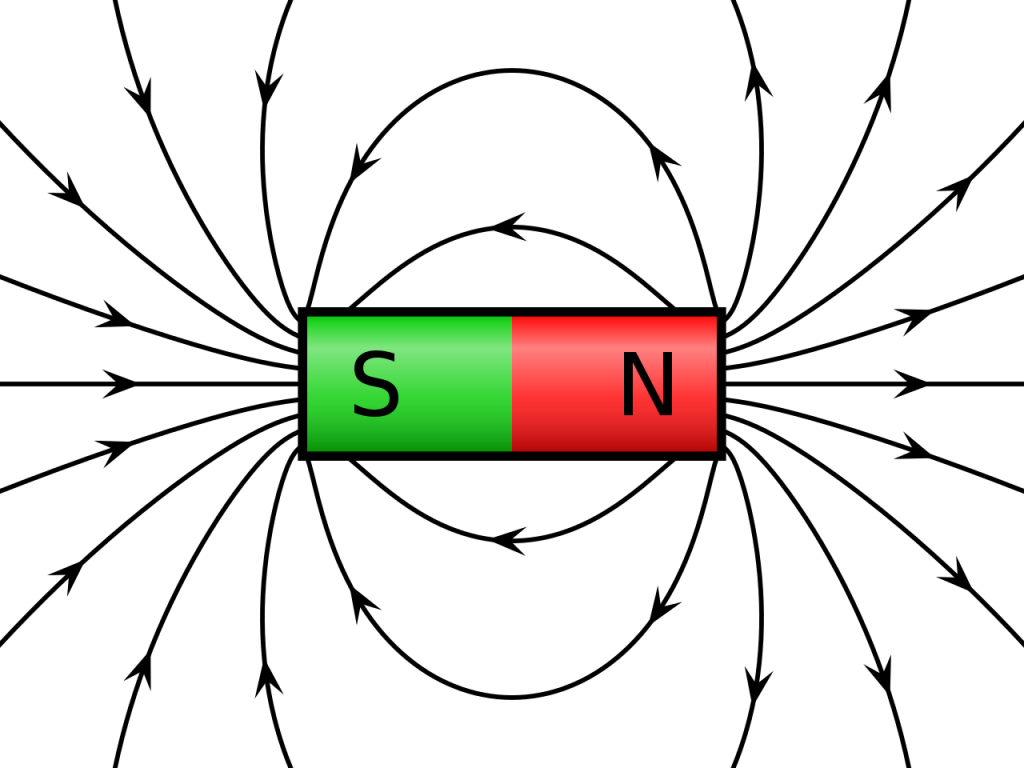
For further explanation of magnetism, watch the following video:
Video credit: “Introduction to Magnetism” by Khan Academy is licensed under CC BY-NC-SA 3.0. Note: All Khan Academy content is available for free at khanacademy.org.
It is a common misconception that all metals are magnetic–only certain metals become magnetized when exposed to a magnetic field. These include iron, nickel, and cobalt.
All matter is made up of atoms. Electrons, negatively charged particles, move around the nucleus of an atom. The movement of electrons generates a magnetic field. In most atoms, electron pairs move in opposite directions so they cancel each other out. Metals like iron, however, have unpaired electrons. When exposed to a strong magnet, these electrons in the iron line up and act like tiny bar magnets. Thus, the iron is magnetized.
The image, below, shows a bar magnet surrounded by iron filings. The electrons in the iron atoms line up and the iron becomes magnetized when it is exposed to the bar magnet so we can see the shape of the magnetic field.
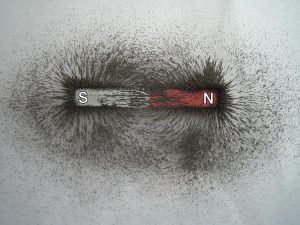
If you have a stainless steel refrigerator, you may have noticed that magnets do not stick to the front. Although steel is made from iron (a magnetic metal), the stainless steel in refrigerators is usually mixed with other metals to make it more durable. This changes the structure of the metals so the stainless steel is not magnetic.
Key Takeaways
All metals are NOT magnetic. Metals that can become magnetized are
- Iron
- Cobalt
- Nickel
Earth’s Magnetic Field
Earth is surrounded by a giant magnetic field called the magnetosphere. Earth has a solid iron core surrounded by liquid iron. As the liquid metal moves around, it generates an electric current which creates a magnetic field around the planet between the geomagnetic poles. As seen in the image, below, the Earth’s geomagnetic poles are tilted from the North and South poles.
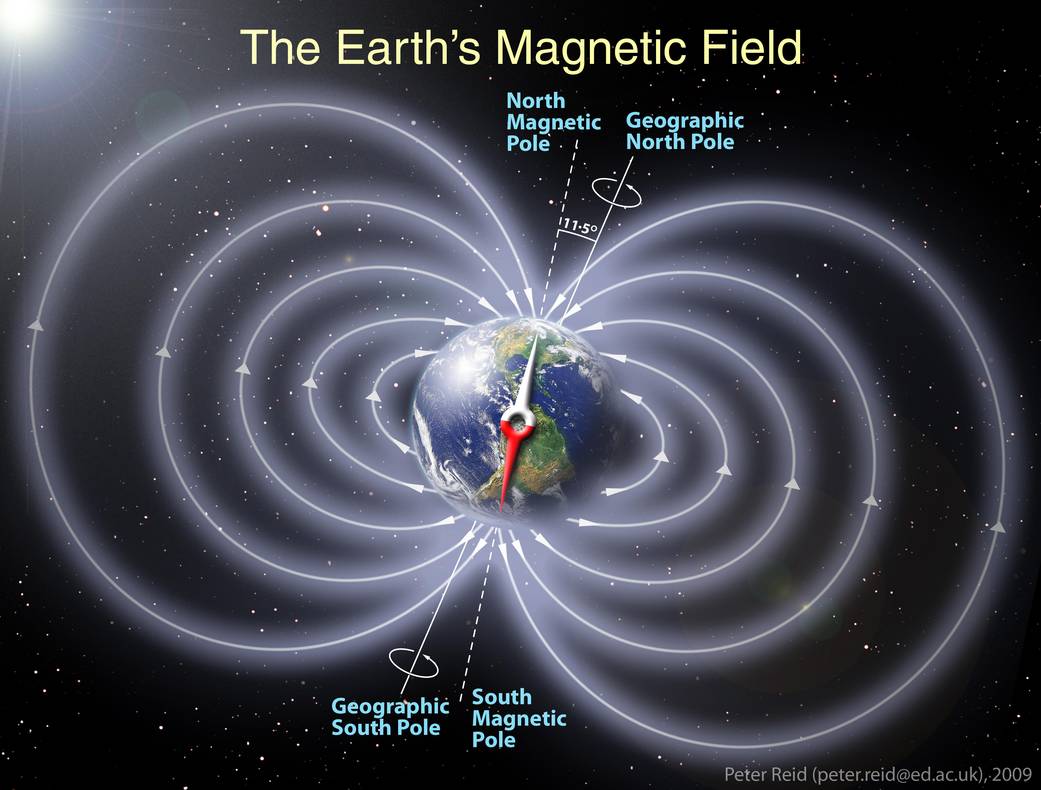
Earth’s magnetic field is critical to life on Earth because it protects the planet from the Sun. The Sun produces solar wind which moves extremely quickly through space. As seen in the image, below, the solar wind is strong enough to shape Earth’s magnetic field; it is flatter on the front and cone shaped on the backside of the planet. Still, the magnetosphere protects Earth from the strongest effects of the solar wind.
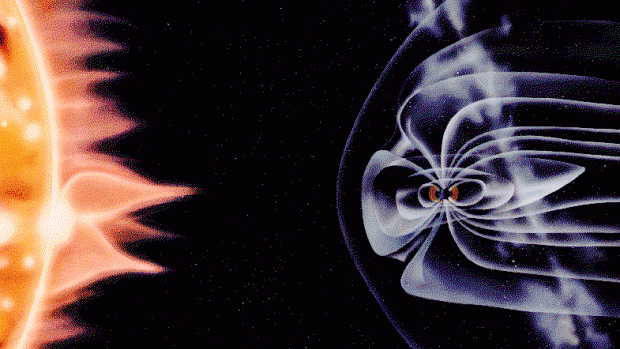
Compasses
Compasses are used to navigate because their needle points to the magnetic north pole. Historians believe that ancient Chinese civilizations used magnetic compasses in the 11th or 12th century. Later, European explorers used compasses to navigate around the world.
The design of early compasses was simple. First, a needle was rubbed along a magnet to magnetize it. Then, the needle was placed on a piece of cork which floated in a bowl of water. This allowed the needle to spin freely and orient to magnetic north.
It isn’t well understood, but scientists also believe that certain animals like whales, turtles, and bees use Earth’s magnetic field to navigate. This is how they are able to travel long distances without getting lost.
Auroras
Auroras are displays of light in the sky. In the Northern Hemisphere this is known as the aurora borealis; in the Southern Hemisphere is is called the aurora australis. The auroras can be seen in far north and far south locations close to the poles.

During a solar storm, the Sun sends out a huge cloud of electrified gas which is carried through space by solar wind. Some of these particles get past Earth’s magnetic field and enter the atmosphere at the North and South poles where the atmosphere is thinner. The solar gases interact with the gases in Earth’s atmosphere which causes the light displays. Oxygen causes the lights to show up as green while nitrogen produces a blue or purple aurora.
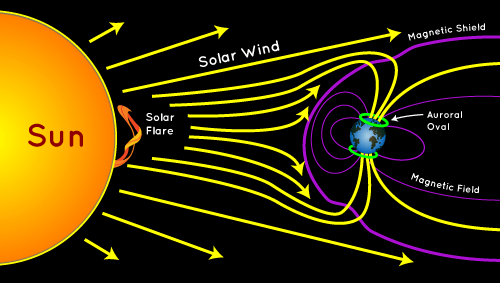
For more explanation of the magnetosphere and auroras, watch the following video:
Video credit: “What is an Aurora?” by Michael Molina/TED-Ed is licensed under CC BY-NC-ND 4.0
Performance Expectations:
| K-PS2-1. | <span class="popup" style="cursor: pointer" title="" data-original-title="
Planning and Carrying Out InvestigationsPlanning and carrying out investigations to answer questions or test solutions to problems in K–2 builds on prior experiences and progresses to simple investigations, based on fair tests, which provide data to support explanations or design solutions.
“>Plan and conduct an investigation to compare <span class="popup " style="cursor: pointer" title="" data-original-title=" Cause and Effect
“>the effects of <span class="popup" style="cursor: pointer" title="" data-original-title=" PS2.A: Forces and Motion
PS2.B: Types and Interactions
PS3.C: Relationship Between Energy and Forces
“>different strengths or different directions of pushes and pulls on the motion of an object. [Clarification Statement: Examples of pushes or pulls could include a string attached to an object being pulled, a person pushing an object, a person stopping a rolling ball, and two objects colliding and pushing on each other.] [Assessment Boundary: Assessment is limited to different relative strengths or different directions, but not both at the same time. Assessment does not include non-contact pushes or pulls such as those produced by magnets.] |
|---|
| K-PS2-2. | <span class="popup" style="cursor: pointer" title="" data-original-title="
Analyzing and Interpreting DataAnalyzing data in K–2 builds on prior experiences and progresses to collecting, recording, and sharing observations.
“>Analyze data to determine if <span class="popup" style="cursor: pointer" title="" data-original-title=" ETS1.A: Defining Engineering Problems
“>a design solution works as intended <span class="popup" style="cursor: pointer" title="" data-original-title=" Cause and Effect
“>to change <span class="popup" style="cursor: pointer" title="" data-original-title=" PS2.A: Forces and Motion
“>the speed or direction of an object with a push or a pull.* [Clarification Statement: Examples of problems requiring a solution could include having a marble or other object move a certain distance, follow a particular path, and knock down other objects. Examples of solutions could include tools such as a ramp to increase the speed of the object and a structure that would cause an object such as a marble or ball to turn.] [Assessment Boundary: Assessment does not include friction as a mechanism for change in speed.] |
|---|
| 3-PS2-3. | <span class="popup" style="cursor: pointer" title="" data-original-title="
Asking Questions and Defining ProblemsAsking questions and defining problems in grades 3–5 builds on grades K–2 experiences and progresses to specifying qualitative relationships.
“>Ask questions to determine <span class="popup" style="cursor: pointer" title="" data-original-title=" Cause and Effect
“>cause and effect relationships <span class="popup" style="cursor: pointer" title="" data-original-title=" PS2.B: Types of Interactions
“>of electric or magnetic interactions between two objects not in contact with each other. [Clarification Statement: Examples of an electric force could include the force on hair from an electrically charged balloon and the electrical forces between a charged rod and pieces of paper; examples of a magnetic force could include the force between two permanent magnets, the force between an electromagnet and steel paperclips, and the force exerted by one magnet versus the force exerted by two magnets. Examples of cause and effect relationships could include how the distance between objects affects strength of the force and how the orientation of magnets affects the direction of the magnetic force.] [Assessment Boundary: Assessment is limited to forces produced by objects that can be manipulated by students, and electrical interactions are limited to static electricity.] |
|---|
| 3-PS2-4. | <span class="popup" style="cursor: pointer" title="" data-original-title="
Asking Questions and Defining ProblemsAsking questions and defining problems in grades 3–5 builds on grades K–2 experiences and progresses to specifying qualitative relationships.
“>Define a simple design problem <span class="popup" style="cursor: pointer" title="" data-original-title=" Interdependence of Science, Engineering, and Technology
“>that can be solved by applying scientific ideas <span class="popup" style="cursor: pointer" title="" data-original-title=" PS2.B: Types of Interactions
“>about magnets.* [Clarification Statement: Examples of problems could include constructing a latch to keep a door shut and creating a device to keep two moving objects from touching each other.] |
|---|
| MS-PS2-3. | <span class="popup" style="cursor: pointer" title="" data-original-title="
Asking Questions and Defining ProblemsAsking questions and defining problems in grades 6–8 builds from grades K–5 experiences and progresses to specifying relationships between variables, and clarifying arguments and models.
“>Ask questions about data to determine <span class="popup" style="cursor: pointer" title="" data-original-title=" PS2.B: Types of Interactions
“>the factors <span class="popup" style="cursor: pointer" title="" data-original-title=" Cause and Effect
“>that affect <span class="popup" style="cursor: pointer" title="" data-original-title=" PS2.B: Types of Interactions
“>the strength of electric and magnetic forces. [Clarification Statement: Examples of devices that use electric and magnetic forces could include electromagnets, electric motors, or generators. Examples of data could include the effect of the number of turns of wire on the strength of an electromagnet, or the effect of increasing the number or strength of magnets on the speed of an electric motor.] [Assessment Boundary: Assessment about questions that require quantitative answers is limited to proportional reasoning and algebraic thinking.] |
|---|
| MS-PS2-5. | <span class="popup" style="cursor: pointer" title="" data-original-title="
Planning and Carrying Out InvestigationsPlanning and carrying out investigations to answer questions or test solutions to problems in 6–8 builds on K–5 experiences and progresses to include investigations that use multiple variables and provide evidence to support explanations or design solutions.
“>Conduct an investigation and evaluate the experimental design to provide evidence that <span class="popup" style="cursor: pointer" title="" data-original-title=" PS2.B: Types of Interactions
“>fields exist between objects <span class="popup" style="cursor: pointer" title="" data-original-title=" Cause and Effect
“>exerting forces on each other <span class="popup" style="cursor: pointer" title="" data-original-title=" PS2.B: Types of Interactions
“>even though the objects are not in contact. [Clarification Statement: Examples of this phenomenon could include the interactions of magnets, electrically-charged strips of tape, and electrically-charged pith balls. Examples of investigations could include first-hand experiences or simulations.] [Assessment Boundary: Assessment is limited to electric and magnetic fields, and limited to qualitative evidence for the existence of fields.] |
|---|
DCI:
Kindergarten
PS2.A: Forces and Motion
- Pushes and pulls can have different strengths and directions.
- Pushing or pulling on an object can change the speed or direction of its motion and can start or stop it.
PS2.B: Types of Interactions
PS3.C: Relationship Between Energy and Forces
Third Grade
PS2.B: Types of Interactions
- Objects in contact exert forces on each other. (3-PS2-1)
- Electric, and magnetic forces between a pair of objects do not require that the objects be in contact. The sizes of the forces in each situation depend on the properties of the objects and their distances apart and, for forces between two magnets, on their orientation relative to each other. (3-PS2-3),(3-PS2-4)
Middle School
PS2.B: Types of Interactions
PS2.B: Types of Interactions
Crosscutting:
Cause and Effect
Lesson Ideas:
Have children explore different objects with magnets. Can they make a statement about what things stick to magnets? Predict what will or won’t stick and try it out. Try going for a magnet hunt around the classroom with magnet to find objects that stick to magnets.
Can you make magnets move objects at a distance? How far can you get?
The area around a magnet that has magnetic force
A flow of electrical charge
North and south axes of Earth's magnetic field
